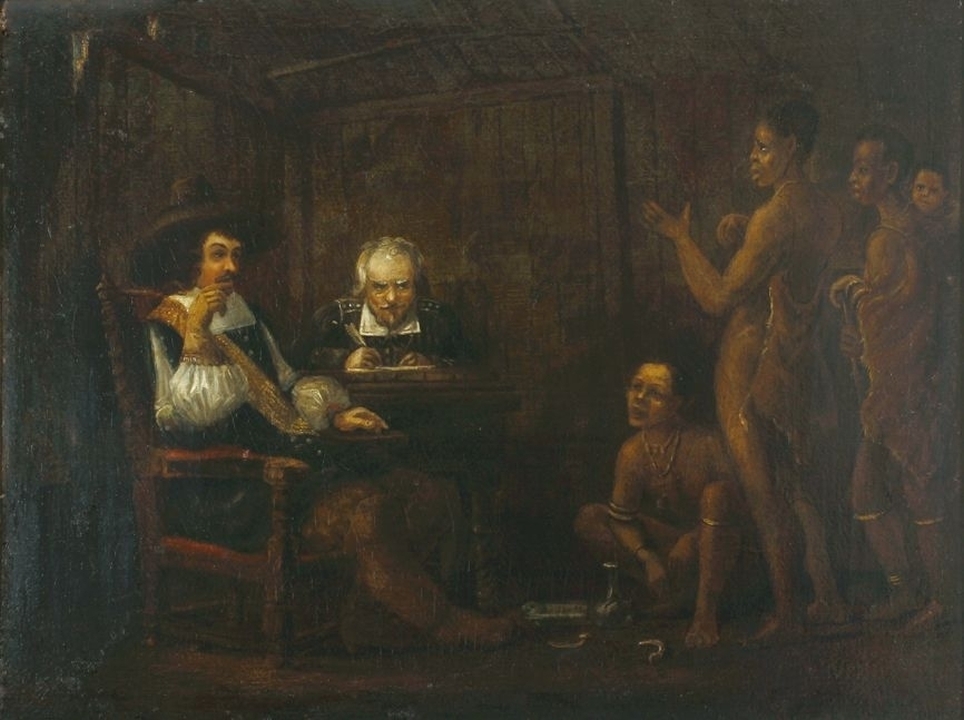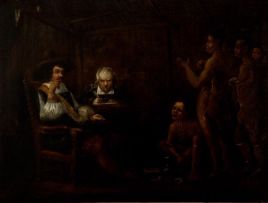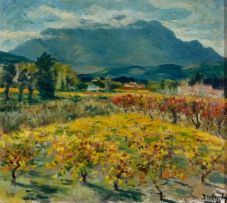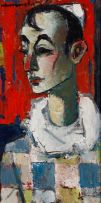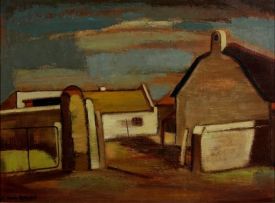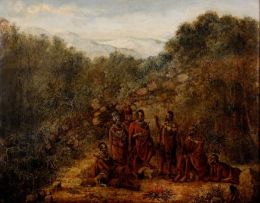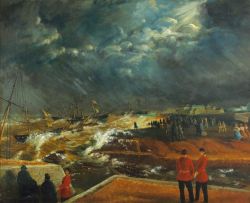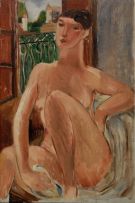Important Paintings, Furniture, Silver and Ceramics
Live Auction, 8 October 2009
Part II - Paintings, Watercolours, Prints and Sculpture
Incl. Buyer's Premium & VAT
About this Item
signed with the artist's initials, indistinctly dated (1850?) and inscribed with the title
Notes
Charles Bell, an accomplished artist and designer, a land surveyor and a director of companies, amongst other activities, was a prominent and respected individual in mid nineteenth century Cape Town. His life and work has recently been the subject of a monograph by Phillida Brooke Simons and Michael Godby, The life and work of Charles Bell, Cape Town, 1997, illustrated in colour p 92.
The painting depicts Jan van Riebeeck and a scribe (most likely Pieter van den Helm, Secretary of the Council of Policy) receiving a group of Strandloopers. They are seated inside a wooden shed, the first structure established at the Cape by the Dutch settlers. This oil stands apart from the rest of Bell's oeuvre in terms of subject and medium. He usually worked in watercolour, and this is one of perhaps half-a-dozen oils that Bell painted. His unusual choice of a historical subject was in response to a challenge by the convenors of the first Fine Arts Exhibition at the Cape in 1851 to introduce the academic category of history painting to the Cape. As it was reported in the Cape Monitor (21.2.1851), Bell exhibited some 'choice historical compositions, the subjects being principally taken from the journal of Van Riebeck [sic], who is conspicuous in most of them'. They were The landing of van Riebeeck, 1652 (for which he won the gold medal for 'best original historical painting'), now in the SA Library: The isle of the Holy Cross depicting the rasing of a cross by Bartholomew Dias in 1487 on the island of St Croix in Algoa Bay (SA Library); two sketches depicting incidents described in van Riebeeck's journal, and what was most likely the present painting, an oil entitled The strandloopers' visit to van Riebeeck. In Michael Godby's opinion, 'Bell's most successful work at the exhibition was that in which he adopted both the medium and technique of academic history painting, which was still at that time regarded as the most noble form of art' (p.155)
Prior to the impressionist movement, the painting of important historical subjects was regarded as the most praiseworthy form of pictorial art. In this group of oils, Bell is arguably the first artist to attempt a pictorial re-creation of the South African past, and his works in this genre precede by about twenty-five years the oils by Thomas Baines depicting the arrival of the 1820 settlers in Algoa Bay. In the catalogue for the 1851 exhibition, Bell provided a reference to his textual source for this picture, which was the usual practice with British history painters exhibiting at the Royal Academy. The two extracts cited from Jan van Riebeeck's journal are: 'April 14 [1652], went on shore to lodge there in a loose plank shed, hastily put together that the work might proceed somewhat faster, &c.', and 'April 29. Saw nothing of any natives from the land of Saldania ... Except sometimes 4 or 5 of the Strand-loopers, who brought with them nothing but lean bodies and hungry bellies, which we filled with some pearly barley and bread, and sometimes a drink of wine; wherefore we should also have some more rice, item arrack, wherewith to treat them and others from the Interior, now and then, so as to make them the more attached to us'.
Because Charles Bell was an amateur rather than a professional artist, he usually retained his work and seldom offered it for sale. This would account for the rarity of his paintings in private hands and for the comprehensive holdings of the UCT Bell Heritage Trust and Museum Africa.
